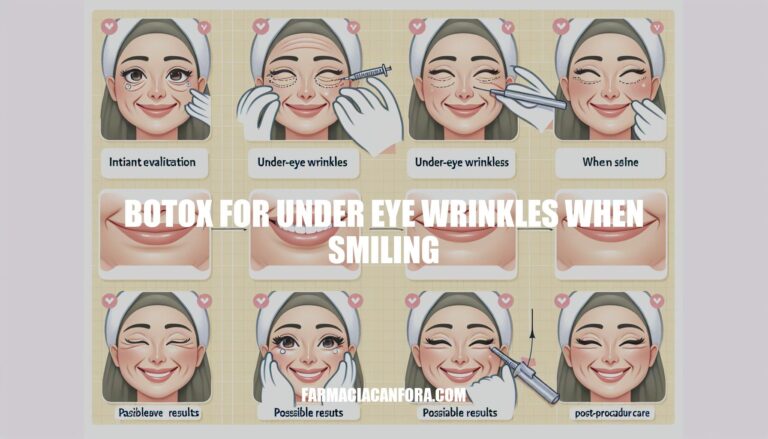Under-eye wrinkles, often called “smile lines” or “crow’s feet,” are common due to the thin, delicate skin in this area and the frequent muscle contractions from smiling. Botox can help by temporarily relaxing these muscles, reducing the appearance of wrinkles and giving a smoother, more youthful look.
How Botox Works for Under Eye Wrinkles When Smiling
Botox works by targeting the muscles responsible for under-eye wrinkles, specifically the orbicularis oculi muscle. When you smile, this muscle contracts, causing wrinkles to form. Botox is injected into this muscle, temporarily paralyzing it. This relaxation prevents the muscle from contracting, thereby reducing the appearance of wrinkles when you smile.
Benefits of Botox for Under Eye Wrinkles When Smiling
Here are the benefits of using Botox for under-eye wrinkles when smiling:
- Reduces Wrinkles and Fine Lines: Botox smooths out the skin under the eyes by relaxing the muscles that cause wrinkles when you smile.
- Youthful Appearance: By minimizing wrinkles, Botox helps you look more youthful and refreshed.
- Brighter Eyes: Botox can make your eyes appear wider and more open, giving you a well-rested look.
- Enhanced Confidence: With fewer wrinkles, you can smile confidently, knowing your under-eye area looks smoother.
- Compliments: Enjoy the positive feedback and compliments about your rejuvenated appearance.
Procedure for Botox for Under Eye Wrinkles When Smiling
Here are the steps involved in the Botox procedure for under-eye wrinkles when smiling:
Pre-Treatment Preparations
- Consultation: Discuss goals, medical history, and any allergies with a board-certified dermatologist.
- Avoid Blood Thinners: Refrain from taking aspirin, ibuprofen, or other blood-thinning medications a few days before the procedure.
- Clean Skin: Ensure the treatment area is clean and free of makeup.
Injection Process
- Marking: The dermatologist marks the injection sites, typically along the orbicularis oculi muscle.
- Anesthesia: A topical anesthetic may be applied to minimize discomfort.
- Injection: Small amounts of Botox are injected into the marked areas using a fine needle.
Post-Treatment Care
- Avoid Rubbing: Do not rub or massage the treated area for at least 24 hours.
- Stay Upright: Remain upright for 4-6 hours post-injection to prevent the Botox from migrating.
- Limit Physical Activity: Avoid strenuous exercise for 24 hours.
- Follow-Up: Schedule a follow-up appointment to assess results and address any concerns.
Potential Side Effects of Botox for Under Eye Wrinkles When Smiling
Botox for under-eye wrinkles can have several side effects and risks, especially when smiling:
- Swelling and Bruising: Common at the injection site.
- Dry or Watery Eyes: Botox can affect the muscles around the eyes, leading to dryness or excessive tearing.
- Droopy Eyelids: Incorrect injection can cause eyelid ptosis, making the eyelids droop.
- Asymmetry: Uneven results can lead to a crooked smile or uneven appearance.
- Pain and Discomfort: Mild pain, headache, or flu-like symptoms can occur.
To minimize these risks:
- Choose an Experienced Practitioner: Ensure your injector is a board-certified professional with experience in facial anatomy.
- Follow Pre- and Post-Care Instructions: Adhere to guidelines provided by your doctor to reduce swelling and bruising.
- Start with a Conservative Dose: Begin with a lower dose to see how your body reacts and adjust as needed.
- Avoid Touching the Area: Refrain from rubbing or massaging the treated area to prevent the toxin from spreading.
Results and Longevity of Botox for Under Eye Wrinkles When Smiling
Botox treatment for under-eye wrinkles when smiling can reduce the appearance of these wrinkles by relaxing the muscles responsible for their formation. The effects typically last around 3 to 4 months.
Botox Treatment for Under-Eye Wrinkles
Botox can effectively reduce under-eye wrinkles caused by smiling, providing a smoother and more youthful appearance.
The treatment involves injecting Botox into the orbicularis oculi muscle to temporarily relax it, preventing wrinkles from forming when you smile.
Benefits include:
- Reduced wrinkles and fine lines
- A more youthful look
- Brighter eyes
- Enhanced confidence
- Compliments
To minimize risks, choose an experienced practitioner, follow pre- and post-care instructions, start with a conservative dose, and avoid touching the treated area.
Results typically last 3 to 4 months.
Consult with a board-certified dermatologist for personalized advice and to discuss any concerns or medical history.


